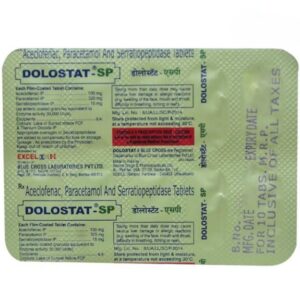PARACETAMOL (ACETAMENOPHEN) + ACECLOFENAC + RABEPRAZOLE
Paracetamol (acetamenophen): Paracetamol, also known as acetaminophen, is a commonly used over-the-counter medication for pain relief and fever reduction. It belongs to the class of drugs called analgesics (pain relievers) and antipyretics (fever reducers).
Paracetamol works by inhibiting prostaglandin synthesis in the central nervous system, which helps to reduce pain and fever. While its mechanism of action is not fully understood, it is believed to act primarily on the enzymes COX-1 and COX-2, which play a role in inflammation and pain signaling.
Paracetamol is used to relieve mild to moderate pain, such as headaches, toothaches, muscle aches, and menstrual cramps. It is also commonly used to reduce fever associated with various illnesses.
The recommended dose of paracetamol for adults and children over 12 years old is generally 325-650 mg every 4-6 hours as needed, up to a maximum of 4,000 mg per day. For children, the dose is based on their weight or age, and it is important to follow the specific dosing instructions provided by a healthcare professional or on the packaging.
While paracetamol is generally considered safe when used as directed, it can have side effects. Common side effects include nausea, stomach upset, and rash. Very rarely, it may cause serious allergic reactions or liver damage. Taking more than the recommended dose can be harmful to the liver, especially when combined with alcohol or in individuals with underlying liver disease. It is important to follow the recommended dose and consult a healthcare professional if symptoms persist or worsen. It is also important to avoid combining paracetamol with other medications that contain acetaminophen to prevent accidental overdose.
Aceclofenac: Aceclofenac is a nonsteroidal anti-inflammatory drug (NSAID) that is commonly used for the treatment of pain and inflammation associated with various conditions, such as arthritis, osteoarthritis, and ankylosing spondylitis. It belongs to the class of drugs known as phenylacetic acid derivatives.
Aceclofenac works by inhibiting the production of prostaglandins, which are chemicals that play a role in pain and inflammation. By reducing the levels of prostaglandins, Aceclofenac helps to relieve pain and inflammation, thus improving the overall symptoms of the underlying condition.
The usual dose of Aceclofenac ranges from 100 mg to 150 mg per day, which can be taken as a single dose or divided into two smaller doses. The dose may vary depending on the severity of the condition and the individual response. It is important to follow the instructions provided by the healthcare professional or stated on the prescription label.
Like other NSAIDs, Aceclofenac may cause certain side effects. The most common side effects include gastrointestinal symptoms such as nausea, vomiting, diarrhea, and abdominal pain. Other potential side effects may include headache, dizziness, rash, itching, and fluid retention. In some cases, long-term use of Aceclofenac may increase the risk of gastrointestinal ulcers and bleeding. Individuals with a history of gastrointestinal disorders, asthma, kidney or liver problems, or those who are pregnant should use Aceclofenac with caution as it may worsen these conditions.
It is important to note that Aceclofenac should be taken under the supervision of a healthcare professional, and it should not be used without a prescription. Additionally, it is advisable to discuss any medication or medical history with a healthcare professional before starting Aceclofenac to ensure its safe use and to minimize the risk of potential side effects or drug interactions.
Rabeprazole: Rabeprazole is a medication that belongs to a class of drugs called proton pump inhibitors (PPIs). It is primarily used to treat conditions caused by excess stomach acid, including gastroesophageal reflux disease (GERD), gastric ulcers, and Zollinger-Ellison syndrome.
The mechanism of action of rabeprazole involves inhibiting a specific enzyme called H+/K+ ATPase in the stomach lining. This enzyme is responsible for the production of stomach acid. By blocking this enzyme, rabeprazole reduces the amount of acid produced in the stomach, providing relief from symptoms associated with excessive acidity.
The typical dose of rabeprazole for adults with GERD is 20 mg once daily for 4 to 8 weeks. For the treatment of gastric ulcers, the recommended dose is 20 mg once daily for 6 weeks. In the case of Zollinger-Ellison syndrome or other conditions that require long-term acid suppression, the initial dose may be higher, up to 60 mg per day, which can be adjusted according to individual needs.
While rabeprazole is generally well-tolerated, there can be some side effects. Common side effects may include headache, abdominal pain, diarrhea, nausea, and flatulence. These side effects are usually mild and temporary. Rare but more serious side effects can include severe allergic reactions, liver problems, or low magnesium levels. It is important to consult a healthcare professional if any of these symptoms occur.
As with any medication, it is crucial to follow the prescribed dosage and consult a healthcare professional for appropriate use and management of side effects.

